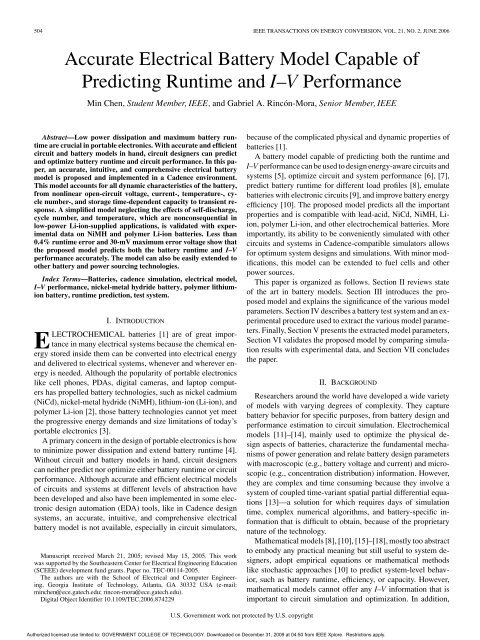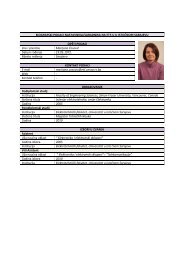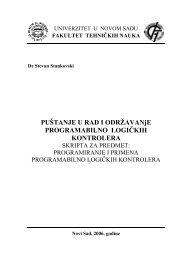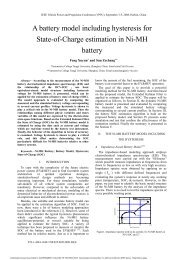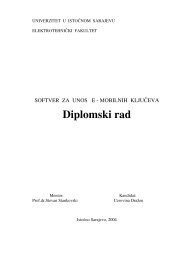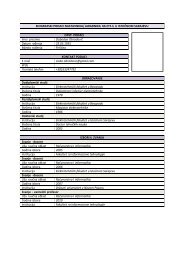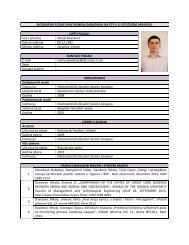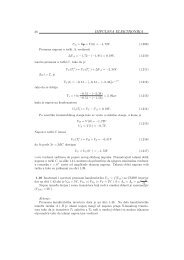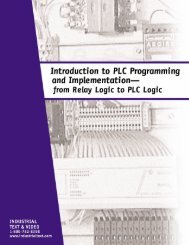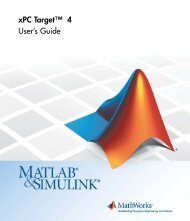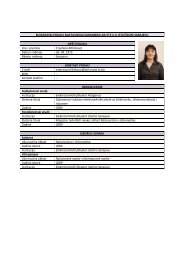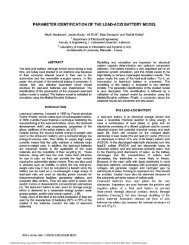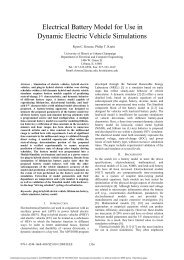Accurate Electrical Battery Model Capable of Predicting Runtime ...
Accurate Electrical Battery Model Capable of Predicting Runtime ...
Accurate Electrical Battery Model Capable of Predicting Runtime ...
You also want an ePaper? Increase the reach of your titles
YUMPU automatically turns print PDFs into web optimized ePapers that Google loves.
504 IEEE TRANSACTIONS ON ENERGY CONVERSION, VOL. 21, NO. 2, JUNE 2006<br />
<strong>Accurate</strong> <strong>Electrical</strong> <strong>Battery</strong> <strong>Model</strong> <strong>Capable</strong> <strong>of</strong><br />
<strong>Predicting</strong> <strong>Runtime</strong> and I–V Performance<br />
Min Chen, Student Member, IEEE, and Gabriel A. Rincón-Mora, Senior Member, IEEE<br />
Abstract—Low power dissipation and maximum battery runtime<br />
are crucial in portable electronics. With accurate and efficient<br />
circuit and battery models in hand, circuit designers can predict<br />
and optimize battery runtime and circuit performance. In this paper,<br />
an accurate, intuitive, and comprehensive electrical battery<br />
model is proposed and implemented in a Cadence environment.<br />
This model accounts for all dynamic characteristics <strong>of</strong> the battery,<br />
from nonlinear open-circuit voltage, current-, temperature-, cycle<br />
number-, and storage time-dependent capacity to transient response.<br />
A simplified model neglecting the effects <strong>of</strong> self-discharge,<br />
cycle number, and temperature, which are nonconsequential in<br />
low-power Li-ion-supplied applications, is validated with experimental<br />
data on NiMH and polymer Li-ion batteries. Less than<br />
0.4% runtime error and 30-mV maximum error voltage show that<br />
the proposed model predicts both the battery runtime and I–V<br />
performance accurately. The model can also be easily extended to<br />
other battery and power sourcing technologies.<br />
Index Terms—Batteries, cadence simulation, electrical model,<br />
I–V performance, nickel-metal hydride battery, polymer lithiumion<br />
battery, runtime prediction, test system.<br />
I. INTRODUCTION<br />
ELECTROCHEMICAL batteries [1] are <strong>of</strong> great importance<br />
in many electrical systems because the chemical energy<br />
stored inside them can be converted into electrical energy<br />
and delivered to electrical systems, whenever and wherever energy<br />
is needed. Although the popularity <strong>of</strong> portable electronics<br />
like cell phones, PDAs, digital cameras, and laptop computers<br />
has propelled battery technologies, such as nickel cadmium<br />
(NiCd), nickel-metal hydride (NiMH), lithium-ion (Li-ion), and<br />
polymer Li-ion [2], those battery technologies cannot yet meet<br />
the progressive energy demands and size limitations <strong>of</strong> today’s<br />
portable electronics [3].<br />
A primary concern in the design <strong>of</strong> portable electronics is how<br />
to minimize power dissipation and extend battery runtime [4].<br />
Without circuit and battery models in hand, circuit designers<br />
can neither predict nor optimize either battery runtime or circuit<br />
performance. Although accurate and efficient electrical models<br />
<strong>of</strong> circuits and systems at different levels <strong>of</strong> abstraction have<br />
been developed and also have been implemented in some electronic<br />
design automation (EDA) tools, like in Cadence design<br />
systems, an accurate, intuitive, and comprehensive electrical<br />
battery model is not available, especially in circuit simulators,<br />
Manuscript received March 21, 2005; revised May 15, 2005. This work<br />
was supported by the Southeastern Center for <strong>Electrical</strong> Engineering Education<br />
(SCEEE) development fund grants. Paper no. TEC-00114-2005.<br />
The authors are with the School <strong>of</strong> <strong>Electrical</strong> and Computer Engineering,<br />
Georgia Institute <strong>of</strong> Technology, Atlanta, GA 30332 USA (e-mail:<br />
minchen@ece.gatech.edu; rincon-mora@ece.gatech.edu).<br />
Digital Object Identifier 10.1109/TEC.2006.874229<br />
because <strong>of</strong> the complicated physical and dynamic properties <strong>of</strong><br />
batteries [1].<br />
A battery model capable <strong>of</strong> predicting both the runtime and<br />
I–V performance can be used to design energy-aware circuits and<br />
systems [5], optimize circuit and system performance [6], [7],<br />
predict battery runtime for different load pr<strong>of</strong>iles [8], emulate<br />
batteries with electronic circuits [9], and improve battery energy<br />
efficiency [10]. The proposed model predicts all the important<br />
properties and is compatible with lead-acid, NiCd, NiMH, Liion,<br />
polymer Li-ion, and other electrochemical batteries. More<br />
importantly, its ability to be conveniently simulated with other<br />
circuits and systems in Cadence-compatible simulators allows<br />
for optimum system designs and simulations. With minor modifications,<br />
this model can be extended to fuel cells and other<br />
power sources.<br />
This paper is organized as follows. Section II reviews state<br />
<strong>of</strong> the art in battery models. Section III introduces the proposed<br />
model and explains the significance <strong>of</strong> the various model<br />
parameters. Section IV describes a battery test system and an experimental<br />
procedure used to extract the various model parameters.<br />
Finally, Section V presents the extracted model parameters,<br />
Section VI validates the proposed model by comparing simulation<br />
results with experimental data, and Section VII concludes<br />
the paper.<br />
II. BACKGROUND<br />
Researchers around the world have developed a wide variety<br />
<strong>of</strong> models with varying degrees <strong>of</strong> complexity. They capture<br />
battery behavior for specific purposes, from battery design and<br />
performance estimation to circuit simulation. Electrochemical<br />
models [11]–[14], mainly used to optimize the physical design<br />
aspects <strong>of</strong> batteries, characterize the fundamental mechanisms<br />
<strong>of</strong> power generation and relate battery design parameters<br />
with macroscopic (e.g., battery voltage and current) and microscopic<br />
(e.g., concentration distribution) information. However,<br />
they are complex and time consuming because they involve a<br />
system <strong>of</strong> coupled time-variant spatial partial differential equations<br />
[13]—a solution for which requires days <strong>of</strong> simulation<br />
time, complex numerical algorithms, and battery-specific information<br />
that is difficult to obtain, because <strong>of</strong> the proprietary<br />
nature <strong>of</strong> the technology.<br />
Mathematical models [8], [10], [15]–[18], mostly too abstract<br />
to embody any practical meaning but still useful to system designers,<br />
adopt empirical equations or mathematical methods<br />
like stochastic approaches [10] to predict system-level behavior,<br />
such as battery runtime, efficiency, or capacity. However,<br />
mathematical models cannot <strong>of</strong>fer any I–V information that is<br />
important to circuit simulation and optimization. In addition,<br />
U.S. Government work not protected by U.S. copyright<br />
Authorized licensed use limited to: GOVERNMENT COLLEGE OF TECHNOLOGY. Downloaded on December 31, 2009 at 04:50 from IEEE Xplore. Restrictions apply.
CHEN AND RINCÓN-MORA: BATTERY MODEL CAPABLE OF PREDICTING RUNTIME AND I–V PERFORMANCE 505<br />
TABLE I<br />
COMPARISON OF VARIOUS CIRCUIT MODELS<br />
Fig. 1. State <strong>of</strong> the art. (a) Thevenin-, (b) impedance-, and (c) runtime-based<br />
electrical battery models.<br />
most mathematical models only work for specific applications<br />
and provide inaccurate results in the order <strong>of</strong> 5%–20% error.<br />
For example, the maximum error <strong>of</strong> Peukert’s law predicting<br />
runtime can be more than 100% for time-variant loads [16].<br />
<strong>Electrical</strong> models [4], [19]–[30], accuracy <strong>of</strong> which lies between<br />
electrochemical and mathematical models (around 1%–<br />
5% error), are electrical equivalent models using a combination<br />
<strong>of</strong> voltage sources, resistors, and capacitors for co-design and<br />
cosimulation with other electrical circuits and systems. For electrical<br />
engineers, electrical models are more intuitive, useful, and<br />
easy to handle, especially when they can be used in circuit simulators<br />
and alongside application circuits. There have been many<br />
electrical models <strong>of</strong> batteries, from lead-acid to polymer Li-ion<br />
batteries. Most <strong>of</strong> these electrical models fall under three basic<br />
categories: Thevenin- [19]–[25], impedance- [26], [27], and<br />
runtime-based models [4], [28], [29], as shown in Fig. 1.<br />
A. Thevenin-Based <strong>Electrical</strong> <strong>Model</strong><br />
In its most basic form, a Thevenin-based model, shown in<br />
Fig. 1(a), uses a series resistor (R Series ) and an RC parallel<br />
network (R Transient and C Transient ) to predict battery response to<br />
transient load events at a particular state <strong>of</strong> charge (SOC), by<br />
assuming the open-circuit voltage [V OC (SOC)] is constant. Unfortunately,<br />
this assumption prevents it from capturing steadystate<br />
battery voltage variations (i.e., dc response) as well as<br />
runtime information.<br />
Its derivative models [19]–[25] gain improvements by adding<br />
additional components to predict runtime and dc response, but<br />
they still have several disadvantages. For example, [19] uses a<br />
variable capacitor instead <strong>of</strong> V OC (SOC) to represent nonlinear<br />
open-circuit voltage and SOC, which complicates the capacitor<br />
parameter, needs the integral over voltage to obtain SOC,<br />
and gives roughly 5% runtime error and 0.4-V error voltage for<br />
constant charge and discharge currents; [20] models the nonlinear<br />
relation between the open-circuit voltage and SOC, but<br />
ignores the transient behavior; [21], [22] and [24] need additional<br />
mathematical equations to obtain the SOC and estimate<br />
runtime, and they are not implemented in circuit simulators; [23]<br />
adopts two constant RC parallel networks, but only works at a<br />
particular SOC and temperature condition; [25] employs a complicated<br />
electrical network extracted from physical process to<br />
model open-circuit voltage (V OC ), which complicates the whole<br />
model. Thus, none <strong>of</strong> these Thevenin-based models can predict<br />
the battery runtime simply and accurately in circuit simulators.<br />
B. Impedance-Based <strong>Electrical</strong> <strong>Model</strong><br />
Impedance-based models, shown in Fig. 1(b), employ the<br />
method <strong>of</strong> electrochemical impedance spectroscopy to obtain<br />
an ac-equivalent impedance model in the frequency domain,<br />
and then use a complicated equivalent network (Z ac ) to fit the<br />
impedance spectra. The fitting process is difficult, complex, and<br />
nonintuitive. In addition, impedance-based models only work<br />
for a fixed SOC and temperature setting [26], and therefore they<br />
cannot predict dc response or battery runtime.<br />
C. <strong>Runtime</strong>-Based <strong>Electrical</strong> <strong>Model</strong><br />
<strong>Runtime</strong>-based models, shown in Fig. 1(c), use a complex<br />
circuit network to simulate battery runtime and dc voltage response<br />
for a constant discharge current in SPICE-compatible<br />
simulators. [28] and [29] are continuous-time implementations<br />
in SPICE simulators and [4] is a discrete-time implementation<br />
using Very high speed integrated circuit Hardware Description<br />
Language (VHDL) code. They can predict neither runtime nor<br />
voltage response for varying load currents accurately.<br />
A brief comparison illustrated in Table I indicates that none<br />
<strong>of</strong> these models can be implemented in circuit simulators to<br />
predict both the battery runtime and I–V performance accurately.<br />
Therefore, a comprehensive battery model combining the<br />
transient capabilities <strong>of</strong> Thevenin-based models, ac features <strong>of</strong><br />
impedance-based models, and runtime information <strong>of</strong> runtimebased<br />
models is highly desired for system design, integration,<br />
and optimization.<br />
III. PROPOSED MODEL<br />
An accurate, intuitive, and comprehensive electrical battery<br />
model is proposed in Fig. 2. On the left, a capacitor (C Capacity )<br />
and a current-controlled current source, inherited from runtimebased<br />
models, model the capacity, SOC, and runtime <strong>of</strong> the battery.<br />
The RC network, similar to that in Thevenin-based models,<br />
simulates the transient response. To bridge SOC to open-circuit<br />
voltage, a voltage-controlled voltage source is used. The proposed<br />
model is a blend <strong>of</strong> previous models whose unique combination<br />
<strong>of</strong> components and dependencies eases the extraction<br />
Authorized licensed use limited to: GOVERNMENT COLLEGE OF TECHNOLOGY. Downloaded on December 31, 2009 at 04:50 from IEEE Xplore. Restrictions apply.
506 IEEE TRANSACTIONS ON ENERGY CONVERSION, VOL. 21, NO. 2, JUNE 2006<br />
Fig. 2.<br />
Proposed electrical battery model.<br />
where Capacity is the nominal capacity in Ahr and f 1 (Cycle)<br />
and f 2 (Temp) are cycle number- and temperature-dependent<br />
correction factors, shown in Fig. 3(a) and (b). By setting the<br />
initial voltage across C Capacity (V SOC ) equal to 1 V or 0 V, the<br />
battery is initialized to its fully charged (i.e., SOC is 100%) or<br />
fully discharged (i.e., SOC is 0%) states. In other words, V SOC<br />
represents the SOC <strong>of</strong> the battery quantitatively.<br />
As seen from (1), C Capacity will not change with current variation,<br />
which is reasonable for the battery’s full capacity because<br />
energy is conserved. The variation <strong>of</strong> current-dependent usable<br />
capacity, shown in Fig. 3(c), comes from different SOC<br />
values at the end <strong>of</strong> discharge for different currents owing<br />
to different voltage drops across internal resistor (the sum<br />
<strong>of</strong> R Series ,R Transient S , and R Transient L ) and the same end<strong>of</strong>-discharge<br />
voltage. When the battery is being charged or<br />
discharged, current-controlled current source I Batt is used to<br />
charge or discharge C Capacity so that the SOC, represented by<br />
V SOC , will change dynamically. Therefore, the battery runtime<br />
is obtained when battery voltage reaches the end-<strong>of</strong>-discharge<br />
voltage.<br />
Self-discharge resistor R Self-Discharge is used to characterize<br />
the self-discharge energy loss when batteries are stored for a<br />
long time. Theoretically, R Self-Discharge is a function <strong>of</strong> SOC,<br />
temperature, and, frequently, cycle number. Practically, it can<br />
be simplified as a large resistor, or even ignored, according to<br />
the capacity retention curve shown in Fig. 3(d), which shows<br />
that usable capacity decreases slowly with time when no load is<br />
connected to the battery.<br />
Fig. 3. Typical battery characteristic curves <strong>of</strong> usable capacity versus (a) cycle<br />
number, (b) temperature, (c) current, and (d) storage time, as well as (e) opencircuit<br />
voltage versus SOC and (f) transient response to a step load-current<br />
event.<br />
procedure, makes a fully Cadence-compatible model possible,<br />
and simultaneously predicts runtime, steady state, and transient<br />
response accurately and “on the fly,” capturing all the dynamic<br />
electrical characteristics <strong>of</strong> batteries: usable capacity (C Capacity ),<br />
open-circuit voltage (V OC ), and transient response (RC network).<br />
A. Usable Capacity<br />
Assuming a battery is discharged from an equally charged<br />
state to the same end-<strong>of</strong>-discharge voltage, the extracted energy,<br />
called usable capacity, declines as cycle number, discharge<br />
current, and/or storage time (self-discharge) increases,<br />
and/or as temperature decreases, as shown in Fig. 3(a)–(d).<br />
The phenomenon <strong>of</strong> the usable capacity can be modeled by<br />
a full-capacity capacitor (C Capacity ), a self-discharge resistor<br />
(R Self-Discharge ), and an equivalent series resistor (the sum <strong>of</strong><br />
R Series ,R Transient S , and R Transient L ).<br />
Full-capacity capacitor C Capacity represents the whole charge<br />
stored in the battery, i.e., SOC, by converting nominal battery<br />
capacity in Ahr to charge in coulomb and its value is defined as<br />
C Capacity = 3600 · Capacity · f 1 (Cycle) · f 2 (Temp) (1)<br />
B. Open-Circuit Voltage<br />
Open-circuit voltage (V OC ) is changed to different capacity<br />
levels, i.e., SOC, as shown in Fig. 3(e). The nonlinear relation<br />
between the open-circuit voltage (V OC ) and SOC is important<br />
to be included in the model. Thus, voltage-controlled voltage<br />
source V OC (V SOC ) is used to represent this relation. The opencircuit<br />
voltage is normally measured as the steady-state opencircuit<br />
terminal voltage at various SOC points. However, for<br />
each SOC point, this measurement can take days [30]. [30] <strong>of</strong>fers<br />
two quick techniques, namely, extrapolation and averaging<br />
techniques, to ascertain the true open-circuit voltage (V OC ).<br />
C. Transient Response<br />
In a step load current event, the battery voltage responds<br />
slowly, as shown in Fig. 3(f). Its response curve usually includes<br />
instantaneous and curve-dependant voltage drops. Therefore,<br />
the transient response is characterized by the shaded RC<br />
network in Fig. 2. The electrical network consists <strong>of</strong> series<br />
resistor R Series and two RC parallel networks composed <strong>of</strong><br />
R Transient S ,C Transient S ,R Transient L , and C Transient L .<br />
Series resistor R Series is responsible for the instantaneous<br />
voltage drop <strong>of</strong> the step response. R Transient S ,C Transient S ,<br />
R Transient L , and C Transient L are responsible for short- and<br />
long-time constants <strong>of</strong> the step response, shown by the two<br />
dotted circles in Fig. 3(f). On the basis <strong>of</strong> numerous experimental<br />
curves, using two RC time constants, instead <strong>of</strong> one or three,<br />
is the best trade<strong>of</strong>f between accuracy and complexity because<br />
Authorized licensed use limited to: GOVERNMENT COLLEGE OF TECHNOLOGY. Downloaded on December 31, 2009 at 04:50 from IEEE Xplore. Restrictions apply.
CHEN AND RINCÓN-MORA: BATTERY MODEL CAPABLE OF PREDICTING RUNTIME AND I–V PERFORMANCE 507<br />
Fig. 4.<br />
<strong>Battery</strong> test system.<br />
two RC time constants keep errors to within 1 mV for all the<br />
curve fittings. The detailed extraction methods can be found<br />
in [23].<br />
Theoretically, all the parameters in the proposed model are<br />
multivariable functions <strong>of</strong> SOC, current, temperature, and cycle<br />
number. However, within certain error tolerance, some parameters<br />
can be simplified to be independent or linear functions<br />
<strong>of</strong> some variables for specific batteries. For example, a<br />
low-capacity battery in a constant-temperature application can<br />
ignore temperature effects, and a frequently used battery can<br />
ignore 5% per month self-discharge rate without suffering any<br />
significant errors.<br />
Fig. 5.<br />
Typical voltage response curve with pulse discharge current.<br />
pulse discharging the battery with currents from 0.1 to 1 C [1] (C<br />
means the discharge current that discharges the nominal battery<br />
capacity in 1 h). Fig. 5 shows a typical discharge curve with<br />
160-mA pulse current on a polymer Li-ion battery. The<br />
pulsewidth is chosen to guarantee enough “humps” (6–10) for<br />
sufficient data points and the <strong>of</strong>f time is selected to allow the<br />
battery voltage to reach steady-state conditions (10 min in this<br />
case). Finally, all the model parameters are extracted from these<br />
experimental curves.<br />
IV. TEST SYSTEM AND PROCEDURE<br />
To extract all the parameters in the proposed model, a battery<br />
test system and an experimental procedure were designed<br />
to measure batteries conveniently and efficiently. As shown in<br />
Fig. 4, the battery test system, implemented on a printed-circuit<br />
board (PCB) prototype, includes a charge circuit, a discharge<br />
circuit, and a computer program. A single-pole double-throw<br />
(SPDT) switch SW1 is used to switch between the charge and<br />
discharge circuits. In the charge circuit, another SPDT switch<br />
SW2 is used to switch between computer-controlled current I C<br />
and constant voltage V Ref to implement constant current charge<br />
for NiCd and NiMH batteries, or constant current-constant voltage<br />
charge for lead-acid, Li-ion, and polymer Li-ion batteries.<br />
In the discharge circuit, another computer-controlled current I D<br />
is used to discharge batteries. Different end-<strong>of</strong>-charge and end<strong>of</strong>-discharge<br />
rules are implemented in the computer program<br />
for various batteries. At the same time, the computer program<br />
monitors battery temperature and samples battery voltage and<br />
current once per second to obtain charge and discharge curves.<br />
Therefore, the battery test system can be used to test various<br />
batteries for model extraction.<br />
The experimental procedure is similar to that in [30]. The major<br />
objective <strong>of</strong> the experimental procedure is to conveniently<br />
obtain the experimental curves <strong>of</strong> Fig. 3, thereby extracting all<br />
the parameters in the proposed model. The curves in Fig. 3(a),<br />
(b), and (d) are obtained by discharging the battery at various<br />
cycle numbers, temperatures, and after different storage time,<br />
respectively. The curves in Fig. 3(c), (e), and (f) are obtained by<br />
V. MODEL EXTRACTION<br />
To validate the proposed model, the model parameters <strong>of</strong> a<br />
specific battery must be identified experimentally first. NiMH<br />
and polymer Li-ion batteries are chosen for model validation<br />
because they are widely popular in portable electronics today.<br />
For clarity, only polymer Li-ion batteries are discussed in the<br />
text, and the model extraction results <strong>of</strong> NiMH batteries are<br />
listed in the Appendix.<br />
As mentioned in Section III, all the parameters in the proposed<br />
model are multivariable functions <strong>of</strong> SOC, current, temperature,<br />
and cycle number. These functions make the model extraction<br />
(i.e., the fitting <strong>of</strong> multivariable functions or multidimensional<br />
lookup tables) complex and the test process (i.e., hundreds <strong>of</strong><br />
cycle measurements at various temperatures) long. Therefore,<br />
some subordinate parameters are simplified or ignored not only<br />
because it eases validation but also because they have negligible<br />
effects in polymer Li-ion batteries, like usable capacity<br />
dependence on self-discharge (2%–10% per month) and cycle<br />
number (less than 10% capacity loss over 300 cycles) [1];<br />
therefore, R Self-Discharge is set to infinity and f 1 (Cycle) is set<br />
to one. Also, the usable capacity dependence on temperature<br />
is minimized for ease because our low-power application incurs<br />
little temperature fluctuations. Experimentally and only<br />
for the purposes <strong>of</strong> extracting parameters, a cooling fan was<br />
used to keep the battery temperature constant so that all the parameters<br />
are independent <strong>of</strong> temperature, i.e., f 2 (Temp) is set<br />
to one.<br />
Authorized licensed use limited to: GOVERNMENT COLLEGE OF TECHNOLOGY. Downloaded on December 31, 2009 at 04:50 from IEEE Xplore. Restrictions apply.
508 IEEE TRANSACTIONS ON ENERGY CONVERSION, VOL. 21, NO. 2, JUNE 2006<br />
Fig. 6.<br />
A 320-mA pulse discharge curves <strong>of</strong> ten polymer Li-ion batteries.<br />
A. Polymer Li-Ion Batteries<br />
Ten new 850-mAh TCL PL-383562 polymer Li-ion batteries<br />
were tested with suitably-spaced pulse discharge currents (80,<br />
160, 320, and 640 mA in this case) at room temperature. For<br />
safety consideration, these batteries were charged with constant<br />
currents less than 800 mA, 4.1-V constant voltage, and 10-mA<br />
end-<strong>of</strong>-charge current, and discharged with pulse currents aforementioned<br />
and 3.0-V end-<strong>of</strong>-discharge voltage. Their pulse discharge<br />
curves under the same conditions (i.e., the same current,<br />
temperature, and cycle number) stay very close to each other.<br />
As shown in Fig. 6, (320-mA pulse discharge curves) ten batteries<br />
show runtime variation within 2% and error voltage less<br />
than 30 mV at 10%–100% SOC. A big error voltage close to<br />
fully discharged states (0%–10% SOC) is caused by the sharp<br />
open-circuit voltage drop that influences battery runtime little.<br />
Because <strong>of</strong> their consistent characteristics, only one polymer Liion<br />
battery needs to be measured, and its model can be applied<br />
to other parts from the same manufacturer.<br />
B. <strong>Model</strong> Extraction<br />
One polymer Li-ion battery whose curves sit in the middle<br />
<strong>of</strong> those <strong>of</strong> other nine batteries was chosen to extract<br />
all the parameters in the proposed model. The fullcapacity<br />
capacitor C Capacity is set to 3060 F according to<br />
(1). Fig. 7 shows the extracted nonlinear open-circuit voltage<br />
[V OC (V SOC )], series resistor (R Series ), and RC network<br />
(R Transient S ,C Transient S ,R Transient L , and C Transient L )as<br />
functions <strong>of</strong> SOC and discharge current. All the extracted RC<br />
parameters are approximately constant over 20%–100% SOC<br />
and change exponentially within 0%–20% SOC caused by the<br />
electrochemical reaction inside the battery. Small parameter differences<br />
among the curves for different discharge currents indicate<br />
that these parameters are approximately independent <strong>of</strong> discharge<br />
currents, which can simplify the model. Single-variable<br />
functions were used to represent these curves, as shown by<br />
V OC (SOC) = −1.031 · e −35·SOC +3.685 + 0.2156 · SOC<br />
− 0.1178 · SOC 2 +0.3201 · SOC 3 (2)<br />
R Series (SOC) = 0.1562 · e −24.37·SOC +0.07446 (3)<br />
R Transient S (SOC) = 0.3208 · e −29.14·SOC +0.04669 (4)<br />
C Transient S (SOC) = −752.9 · e −13.51·SOC + 703.6 (5)<br />
Fig. 7. Extracted parameters <strong>of</strong> the polymer Li-ion battery at room<br />
temperature.<br />
R Transient L (SOC) = 6.603 · e −155.2·SOC +0.04984 (6)<br />
C Transient L (SOC) = −6056 · e −27.12·SOC + 4475. (7)<br />
To verify the accuracy <strong>of</strong> extraction results, these parameters<br />
were applied to the proposed model in a Cadence environment<br />
to simulate the battery voltage response for the same pulse<br />
discharge currents that were used for parameter extraction.<br />
Table II lists the errors <strong>of</strong> voltage and runtime for each<br />
Authorized licensed use limited to: GOVERNMENT COLLEGE OF TECHNOLOGY. Downloaded on December 31, 2009 at 04:50 from IEEE Xplore. Restrictions apply.
CHEN AND RINCÓN-MORA: BATTERY MODEL CAPABLE OF PREDICTING RUNTIME AND I–V PERFORMANCE 509<br />
TABLE II<br />
MODEL EXTRACTION ACCURACY (POLYMER LI-ION BATTERY)<br />
Fig. 8. Comparison between simulation results and experimental data for<br />
(a) 80-, (b) 320-, and (c) 640-mA pulse discharge currents for the polymer<br />
Li-ion battery.<br />
discharge current, and Fig. 8 shows the simulation results and<br />
experimental data <strong>of</strong> 80-, 320-, and 640-mA discharge currents.<br />
The proposed model regenerates voltage response less than<br />
21-mV error and runtime less than 0.12% error <strong>of</strong> polymer<br />
Li-ion batteries accurately. The close agreement manifests the<br />
accuracy <strong>of</strong> the parameter extraction.<br />
VI. MODEL VALIDATION<br />
To validate the extracted model <strong>of</strong> the polymer Li-ion battery,<br />
three different load pr<strong>of</strong>iles, i.e., continuous, pulse, and periodic<br />
four-step discharges, were applied to the polymer Li-ion<br />
battery. The first case is to discharge the polymer Li-ion battery<br />
with an 80-mA continuous current. The simulation results<br />
Fig. 9. Comparison between simulation results and experimental data for<br />
(a) 80-mA continuous, (b) 80-mA pulse, and (c) periodic four-step discharges<br />
for the polymer Li-ion battery.<br />
against experimental data are shown in Fig. 9(a), and they have<br />
15-mV maximum error voltage and 0.395% runtime error. The<br />
second case is to pulse charge the polymer Li-ion battery with<br />
constant current and then constant voltage (80 mA and 4.1 V).<br />
As shown in Fig. 9(b), simulation results match experimental<br />
data well, except during the transition period from constant current<br />
to constant voltage. The cause <strong>of</strong> the discrepancy is that<br />
the polymer Li-ion battery charge circuit modeled in the Cadence<br />
environment has slightly different characteristics with<br />
that implemented in the PCB prototype. The last case is to<br />
discharge the polymer Li-ion battery with a periodic four-step<br />
(0-, 400-, 160-, and 640-mA currents) load pr<strong>of</strong>ile shown in<br />
Fig. 9(c). Similarly, a good match between simulation results and<br />
experimental data, 20-mV maximum error voltage and 0.338%<br />
Authorized licensed use limited to: GOVERNMENT COLLEGE OF TECHNOLOGY. Downloaded on December 31, 2009 at 04:50 from IEEE Xplore. Restrictions apply.
510 IEEE TRANSACTIONS ON ENERGY CONVERSION, VOL. 21, NO. 2, JUNE 2006<br />
TABLE III<br />
MODEL VALIDATION RESULTS (POLYMER LI-ION BATTERY)<br />
runtime error, was reached, indirectly validating the assumptions<br />
that the cycle number and self-discharge have negligible effects<br />
(Table III).<br />
The close agreement between simulation results and experimental<br />
data on NiMH and polymer Li-ion batteries indicates<br />
that the proposed electrical battery model predicts runtime and<br />
both steady-state and transient voltage responses accurately. At<br />
the same time, this model is fully implemented in the Cadence<br />
simulator, an industry standard platform, to codesign<br />
and cosimulate with other circuits and systems, irrespective<br />
<strong>of</strong> the simulation level, circuit, block, or system level simulation.<br />
Furthermore, the proposed model can be extended to<br />
other batteries (e.g., lead-acid, NiCd, Li-ion) and power sources<br />
(e.g., fuel cells).<br />
VII. CONCLUSION<br />
An accurate, intuitive, and comprehensive electrical model<br />
has been proposed to capture the entire dynamic characteristics<br />
<strong>of</strong> a battery, from nonlinear open-circuit voltage, current-,<br />
temperature-, cycle number-, and storage time-dependent<br />
capacity to transient response. Because <strong>of</strong> low self-discharge<br />
rates, long cycle life, and nearly constant temperature applications<br />
(e.g., low power), a simplified model ignoring<br />
self-discharge, cycle number, and temperature has been<br />
validated by comparing simulation results from Cadence with<br />
experimental data on NiMH and polymer Li-ion batteries. The<br />
close agreement between simulations and experiments shows<br />
that the proposed electrical model accurately predicts battery<br />
runtime within 0.4% error and voltage response within 30 mV<br />
to any load pr<strong>of</strong>ile, which is especially important in applications<br />
like pacemakers, where exhausted battery energy or circuit<br />
malfunction endanger human lives. The model is consistently<br />
accurate for over ten polymer Li-ion batteries at 2% runtime<br />
variation and 30-mV error voltage at 10%–100% SOC. In all,<br />
the proposed model <strong>of</strong>fers circuit and system designers the<br />
possibility to improve system efficiency and prolong battery<br />
runtime for portable electronics by predicting both operation<br />
life and I–V performance accurately, and cosimulating with<br />
other circuits in Cadence-compatible simulators, thereby creating<br />
a next-generation integral simulation platform bridging the<br />
power source to the load application.<br />
APPENDIX<br />
A 750-mAh Duracell HR03 NiMH battery was tested<br />
with suitably-spaced pulse discharge currents (75, 100, 150,<br />
300, 500, and 750 mA in this case) at room temperature.<br />
Fig. 10 shows the extracted open-circuit voltage<br />
Fig. 10.<br />
Extracted parameters <strong>of</strong> the NiMH battery at room temperature.<br />
V OC ,R Series ,R Transient S ,C Transient S ,R Transient L , and C Transient L<br />
as funtions <strong>of</strong> SOC and discharge currents. Unlike polymer Liion<br />
batteries, most parameters <strong>of</strong> the NiMH battery strongly<br />
depend on current. Therefore, two-dimensional lookup tables<br />
with interpolation were created and implemented in the Cadence<br />
environment. Table IV lists the errors <strong>of</strong> voltage and<br />
runtime between simulation results and experimental data for<br />
various discharge current. The proposed model predicts voltage<br />
Authorized licensed use limited to: GOVERNMENT COLLEGE OF TECHNOLOGY. Downloaded on December 31, 2009 at 04:50 from IEEE Xplore. Restrictions apply.
CHEN AND RINCÓN-MORA: BATTERY MODEL CAPABLE OF PREDICTING RUNTIME AND I–V PERFORMANCE 511<br />
TABLE IV<br />
MODEL VALIDATION RESULTS (NIMH BATTERY)<br />
response within 15 mV <strong>of</strong> accuracy and runtime within a 0.34%<br />
margin.<br />
REFERENCES<br />
[1] D. Linden and T. B. Reddy, Handbook <strong>of</strong> Batteries, McGraw-Hill, 3rd ed.<br />
New York: McGraw-Hill, 2002.<br />
[2] L. C. Brush, “Portable devices emerging power solutions,” EDN Power<br />
Supplement, pp. 23–26, Nov. 2003.<br />
[3] E. Y. Chu, “New challenges for rechargeable batteries,” EDN Power Suplement,<br />
pp. 13–20, Sep. 2002.<br />
[4] L. Benini, G. Castelli, A. Macci, E. Macci, M. Poncino, and R. Scarsi,<br />
“Discrete-time battery models for system-level low-power design,” IEEE<br />
Trans. VLSI Syst., vol. 9, no. 5, pp. 630–640, Oct. 2001.<br />
[5] R. Rao, S. Vrudhula, and D. N. Rakhmatov, “<strong>Battery</strong> modeling for<br />
energy-aware system design,” Computer, vol. 36, no. 12, pp. 77–87, Dec.<br />
2003.<br />
[6] H. L. Chan and D. Sutanto, “A new battery model for use with<br />
battery energy storage systems and electric vehicles power systems,”<br />
in Proc. IEEE PES Winter Meeting, vol. 1, Jan. 23–27, 2000, pp.<br />
470–475.<br />
[7] C. J. Zhan, X. G. Wu, V. K. Ramachandaramurthy, M. Barnes, N. Jenkins,<br />
and A. J. Ruddell, “Two electrical models <strong>of</strong> the lead-acid battery used in<br />
a dynamic voltage restorer,” in IEE Proc. Generation, Transmission, and<br />
Distribution, vol. 150, no. 2, Mar., pp. 175–182, 200.<br />
[8] M. Pedram and Q. Wu, “Design considerations for battery-powered electronics,”<br />
in Proc. 1999 Des. Autom. Conf., pp. 861–866.<br />
[9] P. H. Chou, C. Park, J. Park, K. Pham, and J. Liu, “B#: A battery emulator<br />
and power pr<strong>of</strong>iling instrument,” in Proc. Int. Symp. Low Power Design,<br />
2003, pp. 288–293.<br />
[10] C. F. Chiasserini and R. R. Rao, “Energy efficient battery management,”<br />
IEEE J. Sel. Areas Commun., vol. 19, no. 7, pp. 1235–1245, Jul. 2001.<br />
[11] L. Song and J. W. Evans, “Electrochemical-thermal model <strong>of</strong> lithium<br />
polymer batteries,” J. Electrochem. Soc., vol. 147, pp. 2086–2095, 2000.<br />
[12] P. M. Gomadam, J. W. Weidner, R. A. Dougal, and R. E. White, “Mathematical<br />
modeling <strong>of</strong> lithium-ion and nickel battery systems,” J. Power<br />
Sources, vol. 110, no. 2, pp. 267–24, Aug. 2002.<br />
[13] D. W. Dennis, V. S. Battaglia, and A. Belanger, “Electrochemical modeling<br />
<strong>of</strong> lithium polymer batteries,” J. Power Source, vol. 110, no. 2, pp. 310–<br />
320, Aug. 2002.<br />
[14] J. Newman, K. E. Thomas, H. Hafezi, and D. R. Wheeler, “<strong>Model</strong>ing <strong>of</strong><br />
lithium-ion batteries,” J. Power Sources, vol. 119–121, pp. 838–843, Jun.<br />
2003.<br />
[15] R. Rynkiewicz, “Discharge and charge modeling <strong>of</strong> lead acid batteries,”<br />
in Proc. Appl. Power Electron. Conf. Expo., vol. 2, 1999, pp. 707–710.<br />
[16] D. Rakhmatov, S. Vrudhula, and D. A. Wallach, “A model for battery<br />
lifetime analysis for organizing applications on a pocket computer,” IEEE<br />
Trans. VLSI Syst., vol. 11, no. 6, pp. 1019–1030, Dec. 2003.<br />
[17] P. Rong and M. Pedram, “An analytical model for predicting the remaining<br />
battery capacity <strong>of</strong> lithium-ion batteries,” in Proc. Design, Automation,<br />
and Test in Europe Conf. and Exhibition, 2003, pp. 1148–1149.<br />
[18] P. E. Pascoe and A. H. Anbuky, “VRLA battery discharge reserve time<br />
estimation,” IEEE Trans. Power Electron., vol. 19, no. 6, pp. 1515–1522,<br />
Nov. 2004.<br />
[19] Z. M. Salameh, M. A. Casacca, and W. A. Lynch, “A mathematical model<br />
for lead-acid batteries,” IEEE Trans. Energy Convers., vol. 7, no. 1, pp. 93–<br />
98, Mar. 1992.<br />
[20] M. Valvo, F. E. Wicks, D. Robertson, and S. Rudin, “Development and<br />
application <strong>of</strong> an improved equivalent circuit model <strong>of</strong> a lead acid battery,”<br />
in Proc. Energy Convers. Eng. Conf., vol. 2, Aug. 1996, pp. 1159–1163.<br />
[21] M. Ceraolo, “New dynamical models <strong>of</strong> lead-acid batteries,” IEEE Trans.<br />
Power Syst., vol. 15, no. 4, pp. 1184–1190, Nov. 2000.<br />
[22] S. Barsali and M. Ceraolo, “Dynamical models <strong>of</strong> lead-acid batteries:<br />
Implementation issues,” IEEE Trans. Energy Convers., vol. 17, no. 1,<br />
pp. 16–23, Mar. 2002.<br />
[23] B. Schweigh<strong>of</strong>er, K. M. Raab, and G. Brasseur, “<strong>Model</strong>ing <strong>of</strong> high power<br />
automotive batteries by the use <strong>of</strong> an automated test system,” IEEE Trans.<br />
Instrum. Meas., vol. 52, no. 4, pp. 1087–1091, Aug. 2003.<br />
[24] L. Gao, S. Liu, and R. A. Dougal, “Dynamic lithium-ion battery model<br />
for system simulation,” IEEE Trans. Compon. Packag. Technol., vol. 25,<br />
no. 3, pp. 495–505, Sep. 2002.<br />
[25] M. C. Glass, “<strong>Battery</strong> electrochemical nonlinear/dynamic SPICE model,”<br />
in Proc. Energy Convers. Eng. Conf., vol. 1, 1996, pp. 292–297.<br />
[26] S. Buller, M. Thele, R. W. D. Doncker, and E. Karden, “Impedancebased<br />
simulation models <strong>of</strong> supercapacitors and Li-ion batteries for power<br />
electronic applications,” in Conf. Rec. 2003 Ind. Appl. Conf., vol.3,<br />
p. 159601600.<br />
[27] P. Baudry, M. Neri, M. Gueguen, and G. Lonchampt, “Electro-thermal<br />
modeling <strong>of</strong> polymer lithium batteries for starting period and pulse power,”<br />
J. Power Sources, vol. 54, no. 2, pp. 393–396, Apr. 1995.<br />
[28] S. C. Hageman, “Simple pspice models let you simulate common battery<br />
types,” EDN, pp. 17–132, Oct. 1993.<br />
[29] S. Gold, “A pspice macromodel for lithium-ion batteries,” in Proc. 12th<br />
Annu. <strong>Battery</strong> Conf. Applications and Advances, 1997, pp. 215–222.<br />
[30] S. Abu-Sharkh and D. Doerffel, “Rapid test and non-linear model characterization<br />
<strong>of</strong> solid-state lithium-ion batteries,” J. Power Sources, vol. 130,<br />
pp. 266–274, 2004.<br />
power sources.<br />
Min Chen (S’04) was born in Jingdezhen, China.<br />
He received the B.Eng. degree (with highest honors)<br />
and the M.Eng. degree in electrical engineering<br />
from Southeast University, Nanjing, China, in 1999<br />
and 2002, respectively. He is currently pursuing the<br />
Ph.D. degree in electrical and computer engineering<br />
at the Georgia Institute <strong>of</strong> Technology, Atlanta.<br />
His research interests are in the area <strong>of</strong> analog<br />
and power IC design, more specifically, battery and<br />
fuel cell modeling, high-efficiency charger IC design,<br />
and integrated power management for hybrid<br />
Gabriel A. Rincón-Mora (S’91–M’97–SM’01) was<br />
born in Caracas, Venezuela. He received the B.S. degree<br />
(high honors) from the Florida International University,<br />
Miami, and the M.S.E.E. and Ph.D. degrees<br />
from the Georgia Institute <strong>of</strong> Technology (Georgia<br />
Tech.), Atlanta, in 1992, 1994, and 1996, respectively,<br />
all in electrical engineering.<br />
From 1994 to 2001, he worked for Texas Instruments,<br />
as a Senior Integrated Circuits Designer, Design<br />
Team Leader, and Member <strong>of</strong> Group Technical<br />
Staff. In 1999, he was appointed as an Adjunct Pr<strong>of</strong>essor<br />
at Georgia Tech., where he became a full-time faculty member <strong>of</strong> the<br />
School <strong>of</strong> <strong>Electrical</strong> and Computer Engineering in 2001. He has authored Voltage<br />
References—From Diodes to Precision High-Order Bandgap Circuits (New<br />
York, Wiley IEEE Press, 2001) and various conference/journal publications. He<br />
is the holder <strong>of</strong> 22 patents in the field <strong>of</strong> analog and power integrated circuits.<br />
His work focuses on integration (power passives, control circuitry, batteries, and<br />
energy-harvesting sources), high performance, and power efficiency <strong>of</strong> solidstate<br />
devices, circuits, and systems in various flavors <strong>of</strong> Bipolar, CMOS, and<br />
BiCMOS process technologies.<br />
Dr. Rincón-Mora was the Director <strong>of</strong> the Georgia Tech. Analog Consortium.<br />
He was the Vice-Chairman for the Atlanta IEEE Solid-State Circuits Society-<br />
Circuits and Systems (SSCS-CAS) Chapter for 2004 and is now the Chairman.<br />
He was the recipient <strong>of</strong> the National Hispanic in Technology Award from the Society<br />
<strong>of</strong> Pr<strong>of</strong>essional Hispanic Engineers; the Charles E. Perry Visionary Award<br />
from the Florida International University; a Commendation Certificate from the<br />
Lieutenant Governor <strong>of</strong> California for his work and contributions to the field.<br />
He was inducted into the “Council <strong>of</strong> Outstanding Young Engineering Alumni”<br />
by Georgia Tech. and featured the cover <strong>of</strong> Hispanic Business Magazine as one<br />
<strong>of</strong> “The 100 Most Influential Hispanics” and La Fuente (Dallas Morning News<br />
publication), and Nuevo Impacto (Atlanta-based magazine). He is a Member<br />
<strong>of</strong> Tau Beta Pi, Eta Kappa Nu, Phi Kappa Phi, and the Society <strong>of</strong> Hispanic<br />
Pr<strong>of</strong>essional Engineers.<br />
Authorized licensed use limited to: GOVERNMENT COLLEGE OF TECHNOLOGY. Downloaded on December 31, 2009 at 04:50 from IEEE Xplore. Restrictions apply.


